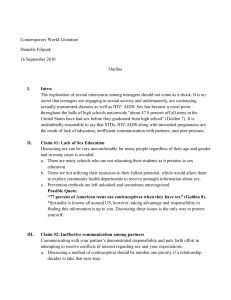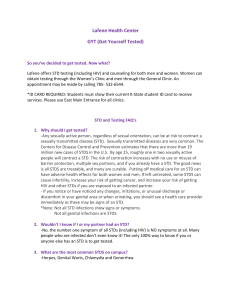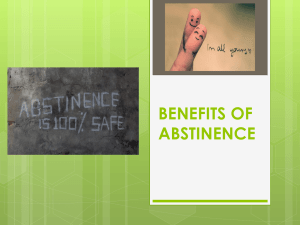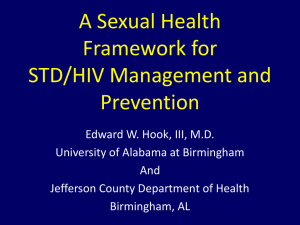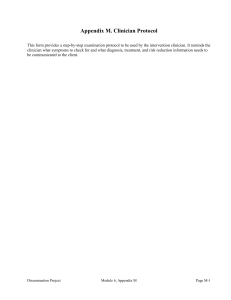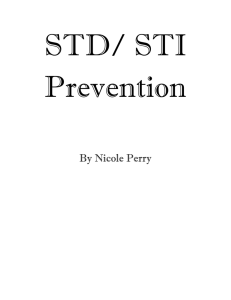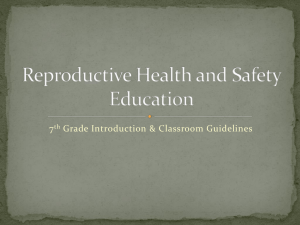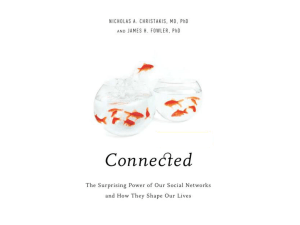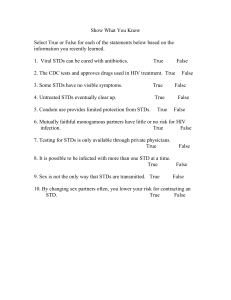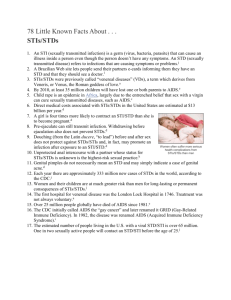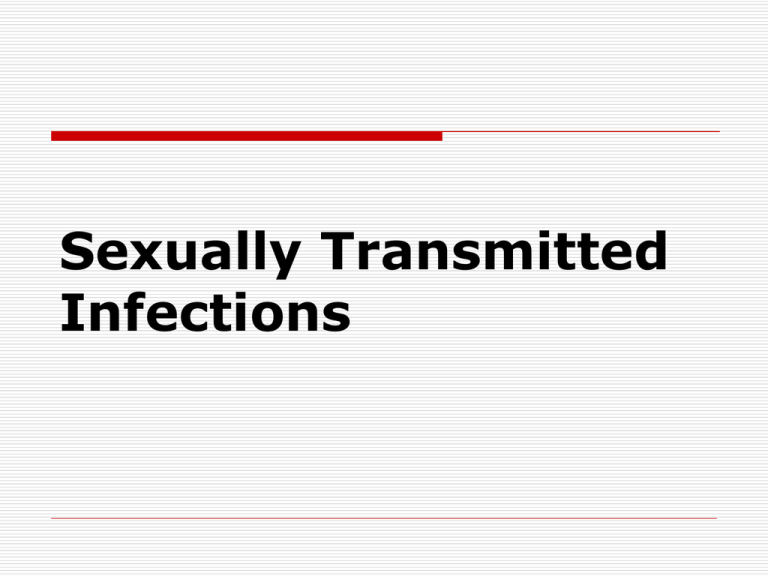
Sexually Transmitted
Infections
What type of STD could
possibly be causing
this to happen?
What is an STI/STD?
STD stands for sexually transmitted disease.
Sexually transmitted diseases can also be called
sexually transmitted infections (STIs).
STDs are spread through sexual behavior or
contact. Some STDs are also transmitted through
skin-to-skin contact or body fluids such as blood,
vaginal fluids, breast milk, pre-ejaculate, or semen.
STDs generally infect the genital area (penis,
scrotum, vulva, and vaginal opening), anus, or
mouth, although they can spread to other parts of
the body if left untreated.
Prevalence
Sexually transmitted diseases (STDs) are
among the most common infectious
diseases in the United States today.
More than 20 different STDs have been
identified, and 13 million men and women
are infected each year in the United
States.
An estimated 1 in 4 sexually active teens
are infected with an STD
What kinds of STDs are out there?
Bacterial infections are caused by a germ or bacteria.
They include Chlamydia, gonorrhea, and syphilis.
These can usually be cured by taking antibiotics.
Viral infections are carried in a person's body and
can't be cured by medicine. They include herpes, HPV,
Hepatitis B and C, and HIV. The symptoms--sores,
warts, or other health problems--can be treated, but
the virus may stay with the person for life, and can be
passed to partners.
Parasitic infections are tiny bugs that live in the pubic
hair and genital area. They include scabies and pubic
lice ("crabs"). They can be spread during sexual
contact and from sharing bath towels, bedding, and
clothing. Scabies and lice are generally eliminated
with prescription soap.
Chlamydia
Most common bacterial STD
No symptoms in 80% of
women and 50% of men
Discharge from the vagina or
the penis, burning or pain
during urination
Transmitted through vaginal,
oral, or anal sexual contact
Ectopic pregnancy and
infertility for women most
serious complications
Treatable with antibiotics
Genital Herpes
One type of herpes typically causes
cold sores in the mouth, and another
type causes genital sores; however,
each type can cause either type of
infection.
Recurring outbreaks of blister-like
sores on the genitals
Can be transmitted from a mother to
her baby during birth
Reduction in frequency and severity of
blister outbreaks with treatment but
not complete elimination of infection.
Hepatitis A, B, C, & D
Hepatitis B most often associated with
sexual contact
Yellowish skin and eyes, fever, achy,
tired, might feel like the flu
Severe complications, including
cirrhosis and liver cancer
No cure available, remission possible
with some aggressive medications
Immunizations available to prevent
hepatitis A and B
Gonorrhea
Discharge from the vagina or the
penis
Painful urination
Ectopic pregnancy and infertility
for women most serious
complications
Treatable with antibiotics
Syphilis
Mild symptoms, often goes undetected
initially
Starts with painless genital ulcer that
goes away on its own
Rash, fever, headache, achy joints
Treatable with antibiotics
More serious complications associated
with later stages of disease if
undetected and untreated
HIV/AIDS
Spread primarily by sexual contact and from
sharing IV needles
Can be transmitted at the time a person
becomes infected with other STDs
Fatigue, night sweats, chills or fever lasting
several weeks, headaches, cough
No current cure and generally fatal, with death
usually occurring after 2-3 years; medication
available to slow disease progression
HIV/AIDS in NJ
Through December of 2008 New Jersey had reported 54,557 cases of AIDS and
ranked 5th out of the 50 states.
Data for Morris County is available from the state as of December 31, 2009. As of
that date…
There were 1342 total cases of HIV/AIDS reported
Out of those 1342 cases, 640 deaths had occurred
Estimated Rates of Persons Living with HIV/AIDS in New Jersey as of December 31,
2009
One in 62 Black non-Hispanics were living with HIV/AIDS.
One in 184 Hispanics were living with HIV/AIDS.
One in 701 White non-Hispanics were living with HIV/AIDS.
Source: New Jersey HIV/AIDS Reporting System as of December 31, 2009 and
bridged-Race population estimates September 2008.
Pubic Lice
Very tiny insects living in pubic
hair
Can be picked up from clothing or
bedding
First notice itching in the pubic
area
Treatable with creams, anti-lice
agents, and combing
Scabies
Skin infection caused by a tiny
mite
Highly contagious
Spread primarily by sexual
contact or from contact with skin,
infested sheets, towels, or
furniture
Treatment with creams
HPV
100 strains of the virus, 40 live in the genital area and
are sexually transmitted
75% of sexually active people will contract HPV
during their lifetime
Spread through skin-to-skin contact and body fluid
70% of cervical cancers are caused by only two
strains
90% of genital warts are caused by two different
strains
Can only be prevented through complete sexual
abstinence
Diagnosis
Some STDs can be diagnosed without any
tests at all. Other STDs require a blood
test or a sample of any unusual fluid
(such as an abnormal discharge from the
vagina or the penis) to be analyzed in a lab
to help establish a diagnosis.
Some tests are completed while a person
waits; other tests require a few days before
a person may obtain the results.
Treatment
The treatment of an STD varies depending
on the type of STD. Some STDs require a
person to take antibiotic medication
either by mouth or by injection; other
STDs require a person to apply creams or
special solutions on the skin. Often,
reexamination by a doctor is necessary
after the treatment to confirm that the STD
is completely gone.
Some STDs, such as herpes and HIV (which
leads to AIDS), cannot be cured, only
controlled.
Prevention
Avoid sexual contact with others.
If people decide to become sexually active, they can reduce the risk of
developing an STD in these ways:
Be in a monogamous relationship (both sexual partners are each others'
only sexual partner).
Delay having sexual relations as long as possible. The younger people
are when they become sexually active, the higher the lifetime risk for
contracting an STD. The risk also increases with the number of sexual
partners.
Correctly and consistently use a male latex condom.
Have regular checkups.
Learn the symptoms of STDs.
Avoid having sex during menstruation.
Avoid anal intercourse or use a condom.
Avoid douching.


